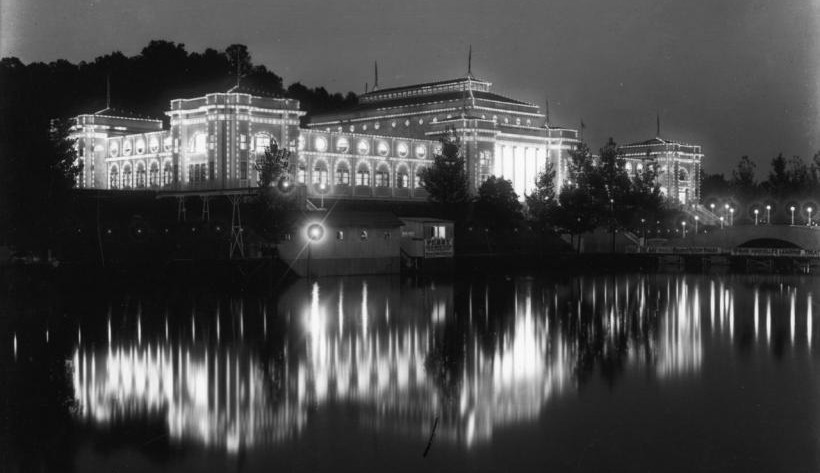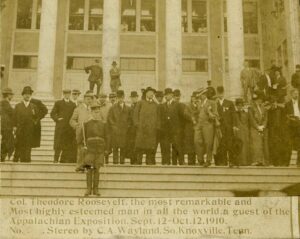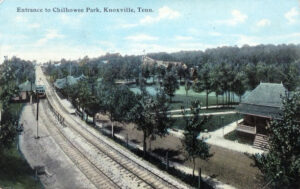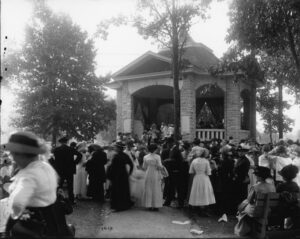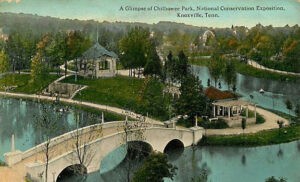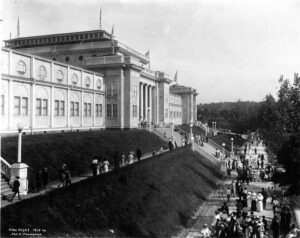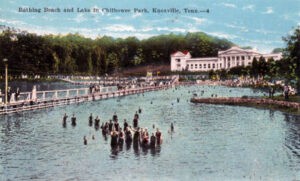The annual Tennessee Valley Fair starts one month from today – Friday, Sept. 9 – at its traditional stomping grounds in East Knoxville, Chilhowee Park, 3301 Magnolia Ave.
For most of us alive today, the fair and the park have always been there, and, in fact, the land has always been there (if you want to get picky!). Chilhowee Park predates the fair by several decades, and its roots extend back to some of Knoxville’s earliest residents.
The site of the park was a farm owned by Revolutionary War veteran Alexander McMillan. His descendants sold the land to college professor Fernando Cortes Beaman (1836-1911) in 1875. Beaman turned part of the land into a park, which became known as Chilhowee Park by the early 1900s.
Beaman developed the 81-acre park, creating a lake, Lake Ottossee, and erecting a dance pavilion. A main road, Park Avenue (now Magnolia Avenue), was constructed to connect the area with downtown. Streetcar-system entrepreneur William Gibbs McAdoo built an electric streetcar line along Park Avenue in 1890.
Knoxville movers and shakers got the nation’s attention focused on Chilhowee Park in 1910 with a Sept. 2-Oct. 2 event called the Appalachian Exposition, which showcased the South’s advances in industry. They repeated their success Sept. 11-Oct. 1, 1911, with a second Appalachian Exhibition.
Former President Theodore Roosevelt spoke at the 1910 and President William Howard Taft at the 1911 Appalachian Exposition. Taft also kicked off the 1910 event by turning on its electric lights remotely from Pennsylvania. The Wright Brothers and Booker T. Washington were some of the luminaries who attended. Between Sept. 1-Oct. 31, 1913, the National Conservation Exposition was held at Chilhowee Park to demonstrate the region’s strides in taking care of the environment.
The first iteration of the fair as we know it today was held in 1916, and it returned in 1917 despite the United States’ entry into the Great War. In its third year, the fair had been running for three days when it was canceled by the influenza epidemic.
In 1920, furniture-store tycoon James G. Sterchi bought Chilhowee Park to use as fairgrounds. He leased it to the East Tennessee Division Fair (as it was called until 1933, when it was renamed the Tennessee Valley Agricultural and Industrial Fair, aka TV A&I Fair. It was reborn as the Tennessee Valley Fair in the 1980s.)
The most historic building remaining at the park is the 1910-era marble bandstand designed by R.F. Graf. But there have been many historic occasions during the fair:
1926 – Knoxville’s first talking picture shown during the fair
1927 – The Jack Dempsey vs. Gene Tunney heavyweight fight broadcast on radios at the fair
1934 – With Prohibition over, beer sold at the fair
1938 – Exhibition Building destroyed by fire
1941 – Rebuild of the Exhibition Building is completed
1942-1945 – Fair canceled by World War II
1943 – The Agricultural and Industrial Exhibition Building is renamed the Jacob Building in honor of Dr. Moses Jacob, former president of the fair board
1946 – First fair since 1941
1948 – Beer sales and bingo games banned
1953 – The Everly Brothers met legendary producer Chet Atkins through a fence near the Homer Hamilton Theatre
1954 – Goodings Million Dollar Midway became midway provider
1955 – “Rock and Roll Review” brought modern popular music to East Tennessee
1958 – “Fairest of the Fair” competition launches
1961 – Carter Myers Arena construction completed
1971 – Petting zoo introduced
1974 – Fair begins opening on Sundays
1975 – Tractor Pull introduced
1976 – Bandstand renovated; “Star Spangled A-Fair” theme celebrates the U.S. Bicentennial
1978 – Jasper the Rooster became official mascot
1999 – Midway relocated to north side of Magnolia Avenue for noise and safety reasons
2004 – Jacob Building renovated and air conditioning added; Wade Shows became midway provider
2019 – East Tennesseans celebrated the 100th fair
2020 – Fair canceled by Covid-19 pandemic
2021 – Fair resumes
2022 – This year’s fair is Sept. 9-18.
The city of Knoxville bought the park in 1926, and it was rechartered as a nonprofit organization in 1931. Year-round operations of the park switched hands between the city and the park organization multiple times throughout the decades.
Billed as “Knoxville’s Only Amusement Park,” Chilhowee Park for many years featured a Ferris wheel, carousel, miniature train, roller coasters, bumper cars and shooting galleries. The amusements fell into disrepair and were eventually removed in the 1980s.
The Tennessee Valley Fair Foundation is a 501(C)(3) nonprofit launched in 2018 “to preserve East Tennessee’s heritage by promoting agricultural awareness, supporting educational programs and cultivating youth development,” according to tnvalleyfair.org. The Cotton Candy Classic 5k race on Saturday, Sept. 10, raises money for the foundation.
The fair annually makes generous gifts to the Love Kitchen and East Tennessee Children’s Hospital, in addition to giving $50,000 to $60,000 in prize money to the winners of youth competitions. The fair also donates to a dozen other area nonprofits. So not only is the Tennessee Valley Fair fun, it’s also rewarding!
Enjoy this photo carousel of old pictures of the park:
Betsy Pickle is a freelance writer and editor who enjoys spotlighting Downtown, South and East Knoxville.

